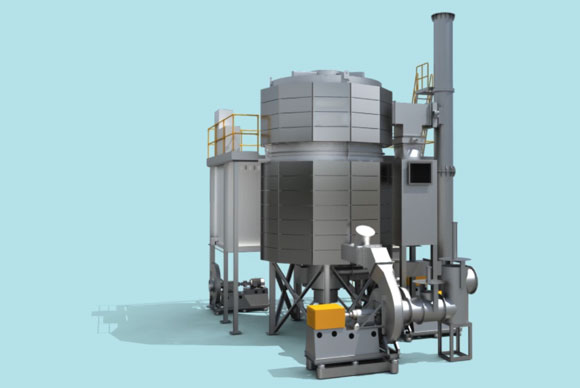What are the best practices for RTO gas treatment system design?
Introduction
In the field of industrial air pollution control, regenerative thermal oxidizers (RTOs) are widely used for treating and purifying exhaust gases. RTO gas treatment system design plays a crucial role in ensuring optimal performance and compliance with environmental regulations. In this article, we will explore the best practices for designing an effective RTO gas treatment system.
1. Proper Sizing and Capacity Planning
One of the key considerations in RTO gas treatment system design is proper sizing and capacity planning. This involves evaluating the volume and composition of the exhaust gas stream, as well as the desired emission reduction targets. By accurately determining the required capacity, the system can be designed to handle the specific gas flow rates, temperature profiles, and pollutant concentrations, ensuring efficient operation.
2. Heat Recovery Efficiency
Maximizing heat recovery efficiency is essential for optimizing the overall energy consumption of an RTO gas treatment system. This can be achieved through the selection of appropriate heat exchangers and thermal insulation materials. Effective heat transfer and insulation minimize heat losses and improve the system’s thermal efficiency, resulting in reduced operating costs and environmental impact.

3. Proper Material Selection
Choosing the right materials for construction is critical in ensuring the longevity and reliability of an RTO gas treatment system. Corrosion-resistant materials, such as stainless steel or specialized alloys, should be used to withstand the corrosive nature of certain exhaust gases. Additionally, high-temperature insulation materials are required to prevent heat transfer to external components and maintain optimal operating conditions.
4. Advanced Control and Monitoring Systems
An effective RTO gas treatment system should be equipped with advanced control and monitoring systems. These systems enable real-time data acquisition, process optimization, and remote control capabilities. By continuously monitoring key parameters such as temperature, pressure, and pollutant concentrations, operators can ensure optimal system performance, troubleshoot issues promptly, and meet regulatory requirements.
5. Effective Combustion Chamber Design
The design of the combustion chamber significantly impacts the performance and efficiency of an RTO gas treatment system. A well-designed combustion chamber ensures proper mixing of the exhaust gases with the combustion air, promotes complete combustion, and minimizes the formation of harmful byproducts. Factors such as residence time, turbulence, and uniform distribution of gases should be carefully considered during the design phase.
6. Reliable Valves and Dampers
Reliable valves and dampers are essential components of an RTO gas treatment system. They control the flow of gases, direct the exhaust stream to the appropriate chambers, and prevent the leakage of untreated gases. Proper sizing, selection, and maintenance of valves and dampers are vital to maintain system integrity, optimize performance, and minimize emissions.
7. Continuous Maintenance and Upkeep
Regular maintenance and upkeep are crucial for the long-term operation and performance of an RTO gas treatment system. This includes routine inspections, cleaning, lubrication, and replacement of worn-out components. By implementing a proactive maintenance plan, operators can prevent unscheduled downtime, extend equipment lifespan, and ensure consistent compliance with environmental regulations.
8. Compliance with Environmental Regulations
Finally, an RTO gas treatment system must comply with local and national environmental regulations. Design considerations should include the specific emission limits, monitoring requirements, and reporting obligations. By incorporating these regulatory requirements into the design process, system operators can avoid legal issues, penalties, and reputational damage.
Conclusion
In conclusion, designing an effective RTO gas treatment system requires careful consideration of various factors, including proper sizing, heat recovery efficiency, material selection, control systems, combustion chamber design, valves and dampers, maintenance, and compliance with environmental regulations. By adhering to these best practices, industrial facilities can achieve efficient and sustainable air pollution control while minimizing operational costs and environmental impact.
We are a high-tech enterprise that specializes in providing comprehensive treatment for volatile organic compounds (VOCs) waste gas and carbon reduction and energy-saving technology for high-end equipment manufacturing. Our core technical team consists of more than 60 R&D technicians, including 3 senior engineers at the researcher level and 16 senior engineers, who come from the Aerospace Liquid Rocket Engine Research Institute (Aerospace Sixth Institute). Our team possesses four core technologies, including thermal energy, combustion, sealing, and automatic control. We also have the ability to simulate temperature fields and air flow field simulation modeling and calculation. Furthermore, our team has the ability to test the performance of ceramic thermal storage materials, the selection of molecular sieve adsorption materials, and the experimental testing of the high-temperature incineration and oxidation characteristics of VOCs organic matter.
To support our research and development, we have established several key platforms, including a high-efficiency combustion control technology test platform, a molecular sieve adsorption efficiency test platform, an efficient ceramic thermal storage technology test platform, a super high-temperature waste heat recovery test platform, and a gas fluid sealing technology test platform. Each of these platforms has been meticulously designed to ensure the highest level of accuracy and effectiveness in our research and development efforts.
Our production facility is equipped with state-of-the-art technology that includes an automated steel plate and shaped section shot blasting and painting production line, a manual shot blasting production line, dust removal and environmental protection equipment, an automated paint spraying room, and a drying room. Our production capacity is top-notch and allows us to produce high-quality products at an efficient rate.
We are proud to have received numerous patents and awards for our core technologies. We have submitted a total of 68 patent applications, including 21 invention patents, and have been granted four invention patents, forty-one utility model patents, six design patents, and seven software copyrights. These patents cover key components of our technology, ensuring that we provide our customers with the best products on the market.
We invite you to collaborate with us and take advantage of our six key strengths, including our cutting-edge technology, exceptional R&D capabilities, extensive industry expertise, commitment to quality, efficient production capacity, and outstanding customer service. We look forward to working with you to help your business succeed.
Autor: Miya
